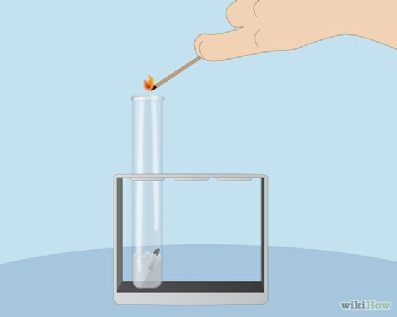





We already know, that when we react a metal with a strong acid we get 2 products.
A Salt and Hydrogen gas (H2)
Acids and Metals


Using your scientific minds answer the following question.
If a Lion at 30 zinc coins, what compound would form in the stomach of the lion?
What would happen to the compound and how would it travel through the lion?
Here is another question.
Chloe places a magnesium ribbon into a test tube filled with hydrochloric acid.
The magnesium strip begins to bubble and slowly disappears.
Why is this?
What are the bubbles filled with?
What is the clear solution left?

Although all metals have similar properties (i.e. shiny, good conductors of heat and electricity) its important to remember they aren’t all the same.
Observe the metals to the side. They are ordered from most reactive to least reactive. Gold doesn't react with diluted acids.
Magnesium
Zinc
Iron
Lead
Copper
Gold
The one thing you notice is that through out all the metal and acid reactions, hydrogen is always produced.
To test for this, we do a ‘pop’ test. Place a piece of metal into an acid, and cover the test tube with your thumb. The gas will build up.
Light a splint, and then hold the splint in the test tube.
Quietly listen, If the splint goes out with a squeaky pop, it’s hydrogen.
Why is there a pop?
What are the 2 elements reacting and what is the product of this reaction?
Questions
1. Copy the sentence and select the correct words:
Some metals react with hydrochloric acid. The products are a salt/an alkali and oxygen/hydrogen gas. Iron reacts more vigorously than magnesium/zinc/lead and less vigorously than magnesium/lead/copper. Some metals, for example, zinc/magnesium, do not react with dilute hydrochloric acid.
2. Iron is a common mineral found in a lot of cereals. Explain what happens when it enters your body. How could you test to see if what you are saying is correct?
3. Fill in the blanks
a. Iron + _______ acid → _____ Chloride + _______
b. ________ + Sulphuric acid →Aluminium ______ + ________
c. _________ + ______ _____ → Magnesium chloride + ______
4. Remember hydrogen gas is a diatomic molecule, this means it only exists in to as H2. Write the following equations out in their balanced chemical equation and draw the molecules for each.
a. Magnesium + sulphuric acid → magnesium sulfate + hydrogen
Mg + H2SO4 → MgSO4 + H2
b. Zinc + Sulphuric acid → Zinc sulphate + hydrogen
c. Magnesium + hydrochloric acid → magnesium chloride + hydrogen
d. Zinc + nitric acid → Zinc nitrate + hydrogen


